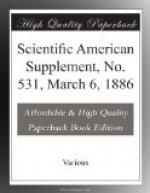“But how about the Indians?” I asked. “Why,” he replied, “we never had any trouble from the Indians. I knew we wouldn’t have. Men who supposed I was such a fool as to go about this undertaking before that was all settled didn’t know me. No Indian ever harmed that line. The Indians are the best friends we have got. You see, we taught the Indians the Great Spirit was in that line; and what was more, we proved it to them. It was, by all odds, the greatest medicine they ever saw. They fairly worshiped it. No Indian ever dared to do it harm.”
“But,” he added, “there was one thing I didn’t count on. The border ruffians in Missouri are as bad as anybody ever feared the Indians might be. They have given us so much trouble that we are now building a line around that State, through Iowa and Nebraska. We are obliged to do it.”
This opened another phase of the subject. The telegraph line to the Pacific had a value beyond that which could be expressed in money. It was perhaps the strongest of all the ties which bound California so securely to the Union, in the dark days of its struggle for existence. The secession element in Missouri recognized the importance of the line in this respect, and were persistent in their efforts to destroy it. We have seen by what means their purpose was thwarted.
I have always felt that, among the countless evidences of the ordering of Providence by which the war for the preservation of the Union was signalized, not the least striking was the raising up of this remarkable man, to accomplish alone, and in the very nick of time, a work which at once became of such national importance.
This is the man who has crowned his useful career, and shown again his eminently practical character and wise foresight, by the endowment of this College, which cannot fail to be a perennial source of benefit to the country whose interests he has done so much to promote, and which his remarkable sagacity and energy contributed so much to preserve.
We have an excellent rule, followed by all successful designers of machinery, which is, to make provision for the extreme case, for the most severe test to which, under normal conditions, and so far as practicable under abnormal conditions also, the machinery can be subjected. Then, of course, any demands upon it which are less than the extreme demand are not likely to give trouble. I shall apply this principle in addressing you to-day. In what I have to say, I shall speak directly to the youngest and least advanced minds among my auditors. If I am successful in making an exposition of my subject which shall be plain to them, then it is evident that I need not concern myself about being understood by the higher class men and the professors.




